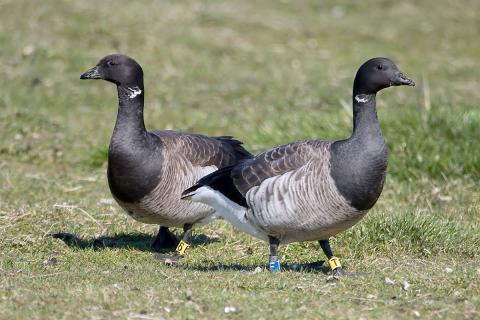Bird ringing

Report a ringed bird find
If you find a ringed bird in Iceland, please report it to the IINH, either by email at fuglamerki@ni.is or by telephoning our office at +354-590-0500. You will receive information about where and when the bird was ringed, the bird’s age, and the distance from the original ringing site.
We request the following information:
- The number on the ring (and the name of the ringing scheme)
- The species of bird (optional, if you can identify it)
- Where you found the bird
- How you found the bird
- The bird’s condition (e.g., had recently died, only the ringed foot was found, and so on)
- Contact information for the finder (name, email, address, phone number)
Project status
Long-term. Bird ringing in Iceland began in 1921. From 1932, the IINH has had responsibility for bird ringing in Iceland.
About the project
Bird ringing is a simple but important way of studying birds and bird migrations. By marking birds, we can track both their movements inside Iceland and migrations across long distances to and from their wintering grounds. Ringing nestlings and young chicks (pulli) is often the only way to observe birds’ lifespans and the ages at which different species reach sexual maturity and begin to breed. Finally, bird ringing can provide population ecologists with crucial data on survival rates, causes of death, age distribution and population size for a given bird population.
The IINH has the sole authority to ring or otherwise mark wild birds in Iceland. Act no. 64/1994 on the protection, conservation and hunting of birds and wild mammals charges the IINH with bird ringing. Under Article 4 of the act, the IINH must ensure that basic data is sorted uniformly and that recoveries are accessible for scientific research. The legislation also states that anyone who finds or captures a ringed/marked bird in Iceland is required to return the marker and details about the find to the IINH, regardless of whether the bird was originally marked in Iceland or abroad. If the bird is alive and well enough to be released again, please note down the markings and report the details of the find to the IINH.
Bird ringing is carried out by bird enthusiasts and ornithologists who have received the necessary ringing permit – so-called bird ringers. A basic ringing permit allows a bird ringer to capture wild birds, fit them with metal bird rings and then release them again after ringing is complete. Other marking is forbidden without an additional permit. Bird ringing is volunteer work, but bird ringers have rights to handle wild birds that others do not.
Bird marking can involve anything from numbered rings or bands to sophisticated satellite transmitters. Traditional bird rings are simple metal bands engraved with a unique number and the address for the ringing scheme. In Iceland, only metal rings from the IINH may be used to ring wild birds. Other markers (such as colour rings and transmitters) may not be placed on a wild bird without a special permit to carry out such research.
Engraved plastic collars or rings fitted on a bird’s neck or leg are often used in certain kinds of ornithological research, for example studies of geese and swans. These rings may be coloured and are coded with one to four letters or numbers, unique for each bird in the study.
Devices such as radio and satellite transmitters and geolocators have also been used to track wild birds’ movements.
Annual bird ringing reports (in Icelandic) are available on the Icelandic version of this page.
IINH Contact: Guðmundur A. Guðmundsson